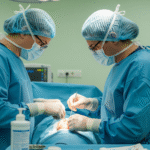Phalloplasty is a complex surgical procedure aimed at constructing or reconstructing a penis. Whether performed for transgender men as part of gender affirmation, or for individuals who have suffered trauma, congenital abnormalities, or penile cancer, phalloplasty offers a transformative solution. In this comprehensive guide, we explore what penile reconstruction surgery entails, who it’s for, techniques used, and what patients can expect before, during, and after recovery.

Who Needs Phalloplasty Surgery?
penile reconstruction surgery is typically recommended for three key patient groups:
Transgender Men
For many trans men, phalloplasty is a gender-affirming surgery that helps align their physical appearance with their gender identity. It allows them to have a neophallus that looks and functions like a biological penis, enhancing emotional and psychological well-being.
Trauma Victims and Cancer Survivors
Individuals who have suffered genital trauma from accidents, burns, or surgical removal due to cancer (such as penile cancer) may seek penile reconstruction to restore normal anatomy and function. These procedures can help regain urinary and sexual function, improving quality of life.
Individuals with Congenital Conditions
Some patients may be born with genital abnormalities or intersex conditions that affect penis development. In such cases, phalloplasty offers both aesthetic and functional benefits.
What Techniques Are Used in Phalloplasty?
Several techniques are available for penile reconstruction, and the choice depends on the patient’s needs, anatomy, and goals. Each method involves using donor tissue (usually from the forearm, thigh, or back) to create a neophallus.
Radial Forearm Free Flap (RFFF)
One of the most common techniques, RFFF uses skin, fat, nerves, and blood vessels from the forearm. It offers excellent tactile and erogenous sensation due to its ability to connect nerves from the donor site to genital nerves. However, it leaves a visible scar on the forearm.
Anterolateral Thigh (ALT) Flap
This technique uses tissue from the thigh, which results in less visible scarring than the forearm approach. Although bulkier, ALT can be a good option for those who prioritize aesthetics and want to avoid upper limb scars.
Latissimus Dorsi Flap
This method uses tissue from the back and may be selected for patients who have limited donor tissue elsewhere. It’s often used in conjunction with other procedures to improve phalloplasty results.
What Happens During Phalloplasty Surgery?
Penile reconstruction surgery is typically performed in stages:
- Creation of the Neophallus – The donor tissue is shaped into a penis and attached to the groin area using microsurgical techniques.
- Urethral Lengthening – Allows the patient to urinate while standing. This may be done during the initial surgery or in a follow-up stage.
- Penile Implant Placement – A penile implant may be inserted later to enable erectile function.
- Scrotoplasty and Glansplasty – Additional procedures to create a scrotum using testicular implants and to sculpt the head of the penis for a natural appearance.
What to Expect After Phalloplasty: Recovery and Results
What Is Phalloplasty After Recovery Like?
Recovery from a penile reconstruction surgery requires patience, as full healing can take several months. Here’s what patients can typically expect during the post-operative period:
- Hospital Stay: Most patients remain in the hospital for 5–7 days post-surgery.
- Catheter Use: A catheter is used to assist with urination until the urethra heals properly.
- Wound Healing: Donor site and phallus incisions will require wound care for several weeks.
- Mobility: Limited movement is advised initially to avoid tension on surgical sites.
- Follow-up Surgeries: Additional stages, such as penile implant insertion, usually occur 6–12 months after the initial operation.
What Are the Typical Phalloplasty Results?
Phalloplasty results vary based on the technique used and individual healing factors. Generally, patients can expect:
- A penis with a natural appearance
- The ability to urinate while standing
- The potential for erotic sensation
- Sexual function with a penile implant
- Psychological benefits, including improved self-confidence and body image
It’s essential to have realistic expectations and to discuss goals with an experienced surgeon.
Is Phalloplasty the Same as Penis Enlargement Surgery?
While penis enlargement surgery typically refers to procedures aimed at increasing the length or girth of an existing penis, phalloplasty involves creating a penis from donor tissue—usually when none existed before or when the original was lost. They are distinctly different in scope, purpose, and complexity.
Choosing the Right Surgeon for Phalloplasty
Given the complexity of penile reconstruction surgery, choosing an experienced, board-certified reconstructive urologist or plastic surgeon is vital. Look for surgeons who specialize in transgender healthcare or genital reconstruction, and review patient testimonials and before-and-after photos.
When consulting a specialist, inquire about:
- Their experience with various phalloplasty techniques
- Success rates and complication risks
- Options for penile implant integration
- Post-surgical support and care planning
Is Phalloplasty Right for You?
Phalloplasty offers life-changing benefits for individuals seeking penile reconstruction—whether for gender affirmation, trauma recovery, or medical conditions. While the journey requires multiple stages and a significant recovery period, the emotional, functional, and aesthetic outcomes can be incredibly rewarding.
If you’re considering phalloplasty, start by consulting with a trusted specialist and exploring your options. Personalized care and detailed planning are key to achieving optimal phalloplasty results and a smoother recovery.



